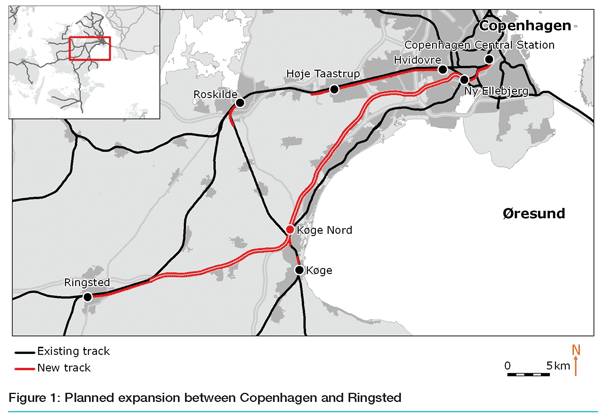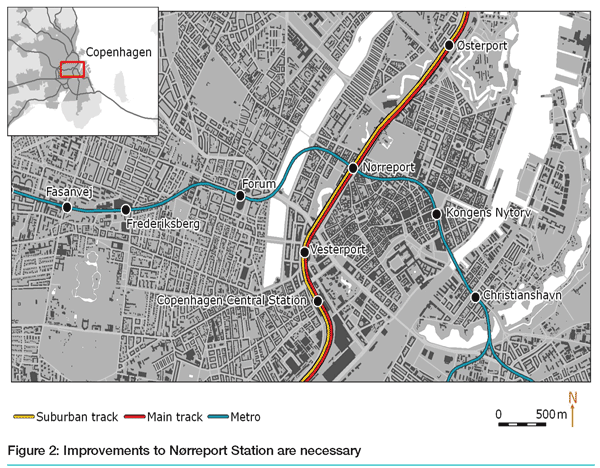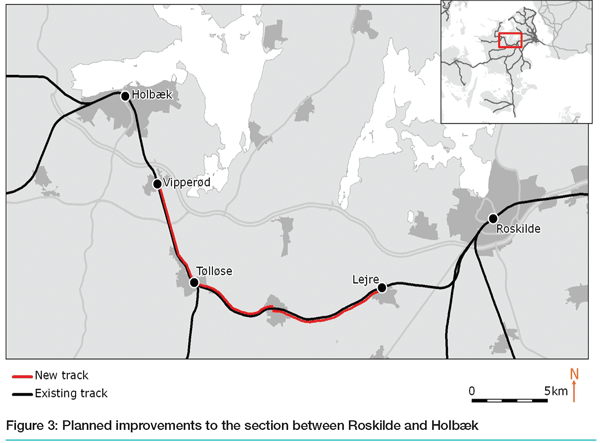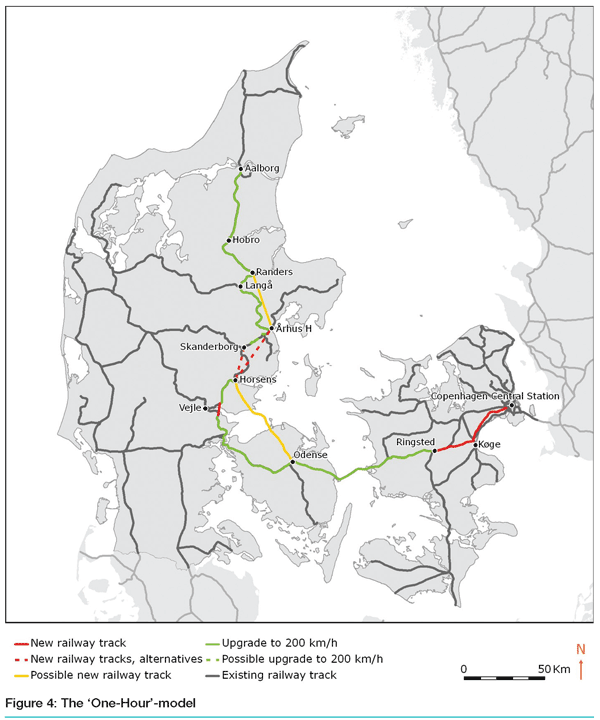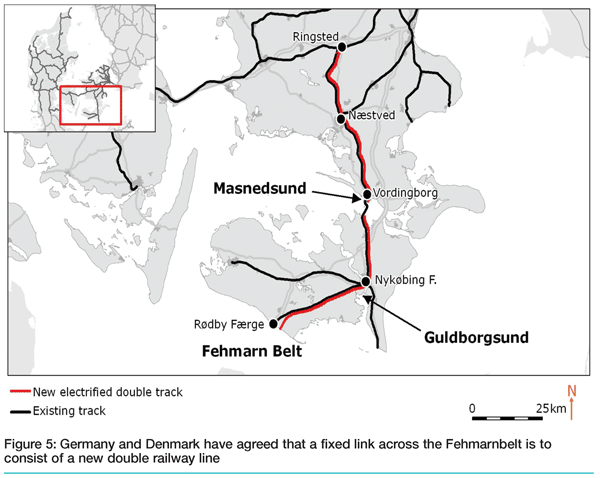The Public Transport Authority in Denmark
Posted: 15 May 2009 | | 2 comments
A summary of Denmark’s Public Transport Authority’s goals, tasks, and railway projects, including expanding capacity between Copenhagen and Ringsted, modernisation of Nørreport Station and improvements to the Northwest Line between Roskilde and Holbæk.
A summary of Denmark's Public Transport Authority's goals, tasks, and railway projects, including expanding capacity between Copenhagen and Ringsted, modernisation of Nørreport Station and improvements to the Northwest Line between Roskilde and Holbæk.
The Public Transport Authority (Trafikstyrelsen) is an agency within the Danish Ministry of Transport and was established on 1 July 2003. Our competence has since been extended to include the fields of ferry services and transport authorities.
Our purview includes the following functions:
- The Danish Government’s railway authority, responsible for regulation, planning, safety and transport co-ordination nationally and internationally
- Adviser to the Ministry of Transport on matters relating to public transport policy and the strategic development of the public transport sector
- Administration of the Danish Government’s procurement of railway and ferry transport services through the organisation of public tenders and management of transport operations contracts
- Administration of the newly established training of future train drivers
- Regulation of tariffs, coordination of public transport and revenue sharing especially in the capital, grants and pool management, data management and market surveillance, framework conditions for rail freight, the EU functions related to public transport and rail freight transport
Goals and main tasks
Through dialogue with all the main players within the field of public transport it is our primary objective to “strengthen the coherence of different means of public transport and to increase its value to society.”
We operate in accordance with our objective as our projects combined constitute a coherent planning of national public transport. The Public Transport Authority is responsible for planning and implementing procurement procedures for operation of ferry and railway services in Denmark. Furthermore, the Public Transport Authority is in charge of following up on the performance of contractors as well as general planning and making the necessary adjustments to the infrastructure.
Combining these diverse areas of responsibilities enables us both to sustain a consistent planning of the railway traffic and to ensure that socio-economic assessments constitute the leading principle regarding the required level of service, capacity extensions and additional adjustments to the infrastructure.
Railway projects
In regard to infrastructure projects, the Public Transport Authority is in charge of performing the analyses that provide the basis for political decisions on railway infrastructure investments.
In general, the initial analyses involve:
- Examining possible technical improvements
- Considering expansion of the number of rail tracks along existing lines
- Contemplating possible new railway lines
A critical point in the studies is cost-benefit analyses to which a great deal of importance is ascribed when it is to be decided politically whether a project is to be carried out. If the project gains political support, the Public Transport Authority will examine the possible impact in terms of transport issues and the environment, and ultimately draw up the final basis for decisions. When a political agreement has been concluded, the project implementation will be assigned to the infrastructure manager, who will be in charge of the actual implementation.
When the Public Transport Authority has handed over a project, we regularly follow up on the ongoing projects to ensure that they are implemented in accordance with the political decision.
Current railway projects
The Public Transport Authority is currently engaged in the following major railway projects:
- Copenhagen – Ringsted
- Modernisation of Nørreport Station
- The Northwest Line between Roskilde and Holbæk
Copenhagen – Ringsted
The project is financially supported by the European Union, and the purpose of expanding capacity between Copenhagen and Ringsted is to relieve the congestion problems caused by the transport bottleneck on the section (see Figure 1).
This section is of key significance for both national and international railway traffic, and it is therefore imperative to act upon the fact that since the opening of the fixed links across the Great Belt and Øresund, capacity has been exhausted.
In March 2007, the Danish Parliament passed the law on projection, according to which the two following solutions are to be examined:
- ‘The fifth track solution’
- ‘The new track solution’
‘The fifth track solution’ involves an additional track along the existing railway line alignment between the two cities Hvidovre and Høje Taastrup. Furthermore, the solution encompasses minor local improvements to capacity on the section between Copenhagen and Ringsted.
‘The new track solution’ involves the construction of a new double railway line along a new alignment from Ny Ellebjerg to Ringsted via Køge.
In the autumn of 2009, the Public Transport Authority will submit the basis for decision-making to the Danish Ministry of Transport. Parallel to the ongoing analyses, two minor parts of the project has already been decided upon since they will represent great value regardless of whether ‘The fifth track solution’ or ‘The new track solution’ is ultimately chosen.
The two minor capacity improvements are:
- Capacity expansion between Copenhagen and the Ny Ellebjerg Station. Two new tracks will be constructed on the approximately 5km-long section, and the tracks are expected operational at the end of the year 2011
- Capacity expansion in Ringsted. An additional track will be constructed in Ringsted
Modernisation of Nørreport Station
Nørreport is the busiest station in Denmark, with approximately 90,000 travellers daily (not including passengers using the Metro). Therefore, it is necessary to improve the conditions at the station (see Figure 2).
The Public Transport Authority is in charge of planning the underground improvements.
The examination focuses particularly on the following aspects:
- Improving the quality of the air underground
- Ensuring that the station will be able to meet the stricter fire safety requirements following the possible renovation
- Modernising the passengers’ conveniences underground
- Coordinating the future modernisation of the underground with the possible modernisation above
The Northwest Line between Roskilde and Holbæk
The Public Transport Authority performs the preliminary plan of improving the section between Roskilde and Holbæk (see Figure 3).
The project aims to achieve the following benefits to passengers:
- Shorter journey time
- Improved punctuality
- Higher train frequency
- Improved timetable
Today, the capacity on the section runs at maximum, resulting in bottlenecks and congestion. The most urgent need for capacity improvement is found between the two villages Lejre and Vipperød, where trains travelling in opposite directions on the single track can only pass each other at the stations.
It has been decided to carry out the project as rapidly as possible. However, it is a particularly important challenge to carry out the project in concordance with the implementation of the European Rail Transport Management System (ERTMS). The Danish implementation plan entails that the ERTMS will not be ready for deployment on the Northwest Line until 2020.
The demand for a rapid implementation of the capacity expansion results in a need for a temporary adaptation of the existing train signal and control systems. The adjustment is a demanding task since the current systems are rather old, and it is consequently difficult to procure the necessary components. Furthermore investment in the existing systems will be sunk costs when ERTMS is established.
This problem occurs within several of the projects of the Public Transport Authority. Therefore, it is of primary interest to also enable future years’ infrastructure projects in the transition period before ERTMS is implemented. Otherwise ERTMS, which we consider necessary for the development of the European railway, could have the unforeseen effect of hampering other important railway developments.
Future work
On 29 January 2009, the Danish Parliament reached a widely supported agreement on a national traffic plan which focuses exceedingly on railway transport. One of the main principles of the agreement is that “…public transport is to account for the majority of the future growth within the transport sector. The railway must be reliable, safe and ultramodern.”
As far as the Public Transport Authority is concerned, the agreement brings about new challenges in the near future inasmuch as we have been appointed to draw up the basis for political decisions – and therefore also to perform the initial analyses and carry out environmental impact assessments (EIA).
The ‘One-Hour’-model
In Denmark a concept called the ‘One-Hour’-model is given much attention, and it is also a prominent topic in the new traffic plan. The model represents a strategic aiming at ensuring significantly shorter travel times on the sections between the major Danish cities.
The aim is to reduce the travel time to one hour on the sections between:
- Copenhagen – Odense
- Odense – Århus
- Århus – Aalborg
It has been planned to implement the ‘One-Hour’-model in several phases (see Figure 4). The first step is the section between Copenhagen and Odense, where a new track between Copenhagen and Ringsted is necessary to achieve the reduced travel time. The second step is dependent on an increase of speed on the section between Århus and Aalborg to 200km/h. The third step concerns the section between Odense and Århus, and it anticipates an extensive effort on the railway net. Therefore this phase is not expected to be completed until after 2020.
Looking ahead, it will hopefully be possible to expand the scope of the model to also include other cities.
In regards to the Public Transport Authority, the ‘One-Hour’-model implies that the current project on Copenhagen-Ringsted is to be completed. Furthermore, the authority is in charge of drawing up the final basis for political decisions concerning all other sections included in the strategy of the ‘One-Hour’-model.
Fehmarnbelt
Germany and Denmark has agreed that a fixed link across the Fehmarnbelt is to consist of a new double railway line and a four-lane motorway between Puttgarden and Rødbyhavn (see Figure 5).
In order to ensure optimal use of the fixed link, it will be necessary to upgrade the road and railway networks in both Denmark and Germany. The two countries have agreed that each will be responsible for constructing and financing their own land works.
The Danish land works consists of the following:
- Electrification on the section between Ringsted and Rødby
- Construction of the new double track between Ringsted and Rødby
- New bridges over the straits Masnedsund and Guldborgsund
The objective is to open the coast-to-coast link across Fehmarnbelt by the end of 2018.
Preparations for the construction work are expected to last for three to four years while the actual construction phase is estimated to last for approximately seven years. The Public Transport Authority will most likely by responsible for technical, environmental as well as financial analyses regarding the Danish land works. These analyses will all be part of the final basis for political decision.
Other projects
In addition to the above mentioned projects, the Public Transport Authority will presumably prepare the basis for political decision regarding other projects.
To mention a few, we expect to perform the initial analyses and carry out environmental impact assessments (EIA) of the following:
- The capacity on the railway across the Sound between Denmark and Sweden, in particular, we will focus upon the capacity of the railway service of Kastrup next to Copenhagen Airport
- The S-train on the section between Copenhagen Central Station and Hillerød 35km north of the capital. The plan is to improve capacity by building more tracks
- Construction of an additional track on the railway line in the southern part of Jutland – namely on the two single-track sections Vamdrup-Vojens and Tinglev-Padborg
Furthermore, the Public Transport Authority expects to be able to carry into effect the following:
- Analyses on a new intermodal terminal, which may be placed outside Køge, 50km south of Copenhagen
- Strategic analysis of further electrification of the Danish railway network
